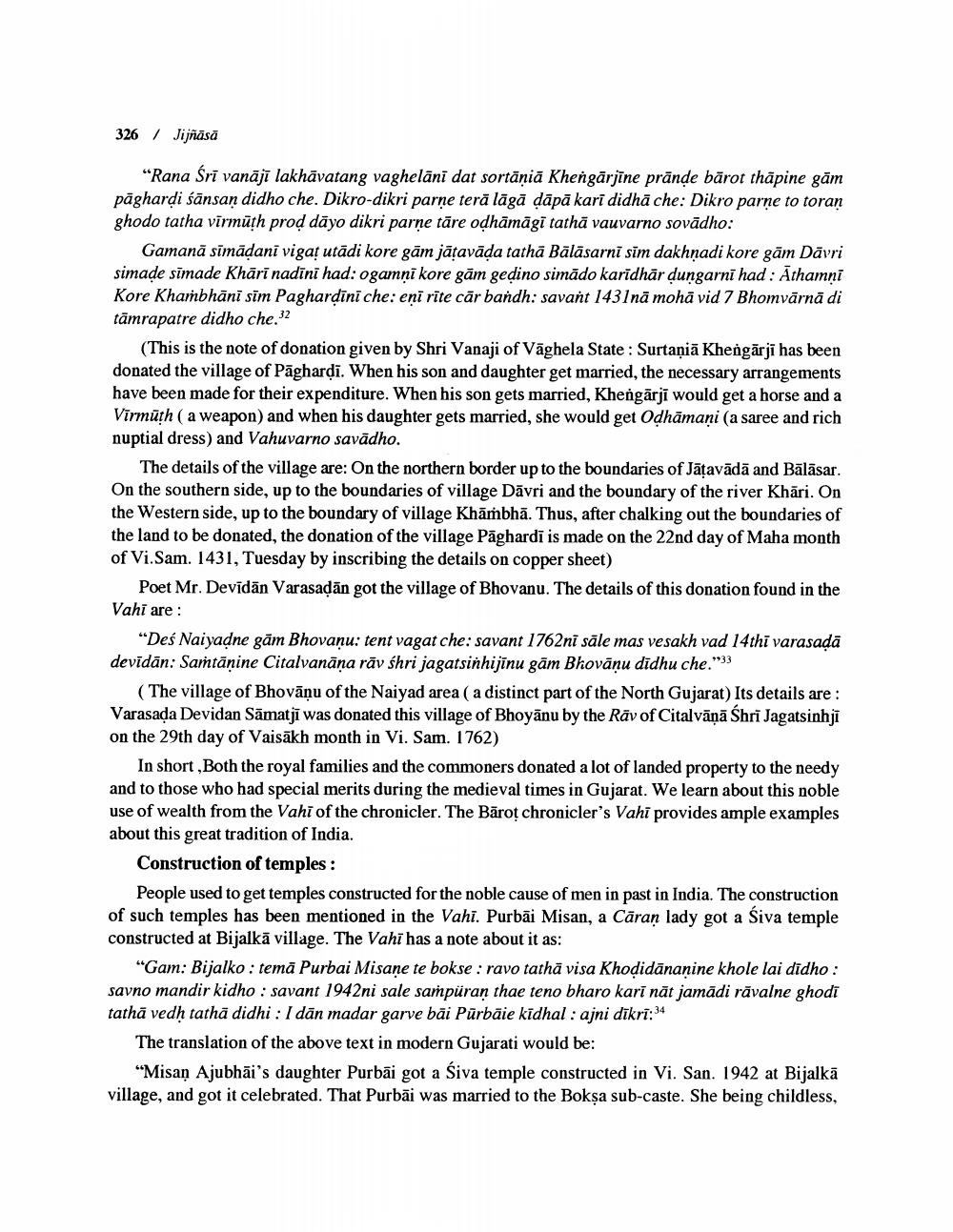________________
326
/
Jijñāsā
“Rana Śrī vanājī lakhāvatang vaghelāni dat sortāṇiā Khengārjīne prānde bārot thāpine gām pāghardi śänsan didho che. Dikro-dikri parne terā lāgā dāpā karī didhā che: Dikro parne to toran ghodo tatha vīrmüth prod dāyo dikri parne tāre odhāmägi tathā vauvarno sovādho:
Gamanā simādani viga utādi kore gām jātavāda tathā Bāläsarni sim dakhnadi kore gām Dāvri simade sīmade Khāri nadini had: ogamņi kore gām gedino simādo karidhār dungarni had : Athamni Kore Khambhāni sim Paghardini che: eni rite car bandh: savant 1431nā mohā vid 7 Bhomvārnā di tāmrapatre didho che.32
(This is the note of donation given by Shri Vanaji of Vāghela State : Surtaņiā Khengārji has been donated the village of Pāghardī. When his son and daughter get married, the necessary arrangements have been made for their expenditure. When his son gets married, Khengārji would get a horse and a Virmūth ( a weapon) and when his daughter gets married, she would get Odhāmaņi (a saree and rich nuptial dress) and Vahuvarno savādho.
The details of the village are: On the northern border up to the boundaries of Jātavādā and Bālāsar. On the southern side, up to the boundaries of village Dāvri and the boundary of the river Khāri. On the Western side, up to the boundary of village Khāṁbhā. Thus, after chalking out the boundaries of the land to be donated, the donation of the village Pāghardī is made on the 22nd day of Maha month of Vi.Sam. 1431, Tuesday by inscribing the details on copper sheet)
Poet Mr. Devidān Varasadān got the village of Bhovanu. The details of this donation found in the Vahi are :
"Des Naiyadne gām Bhovaņu: tent vagat che: savant 1762ni sāle mas vesakh vad 14thi varasada devidān: Samtāṇine Citalvanāņa rāv shri jagatsinhijīnu gām Bhovāņu didhu che."33
(The village of Bhovāņu of the Naiyad area ( a distinct part of the North Gujarat) Its details are: Varasada Devidan Sāmatjī was donated this village of Bhoyānu by the Rāv of Citalvāņā Śhri Jagatsinhji on the 29th day of Vaisākh month in Vi. Sam. 1762)
In short,Both the royal families and the commoners donated a lot of landed property to the needy and to those who had special merits during the medieval times in Gujarat. We learn about this noble use of wealth from the Vahi of the chronicler. The Bārot chronicler's Vahi provides ample examples about this great tradition of India.
Construction of temples:
People used to get temples constructed for the noble cause of men in past in India. The construction of such temples has been mentioned in the Vahi. Purbāi Misan, a Cāran lady got a Siva temple constructed at Bijalkā village. The Vahi has a note about it as:
"Gam: Bijalko : temā Purbai Misane te bokse : ravo tathā visa Khodidānanine khole lai didho: savno mandir kidho : savant 1942ni sale sampüran thae teno bharo kari nāt jamādi rāvalne ghodi tathā vedh tathā didhi : I dān madar garve bāi Pārbāie kidhal : ajni dīkrī:34
The translation of the above text in modern Gujarati would be:
"Misan Ajubhāi's daughter Purbāi got a Siva temple constructed in Vi. San. 1942 at Bijalkā village, and got it celebrated. That Purbāi was married to the Bokşa sub-caste. She being childless,




